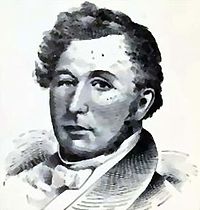John Miller (Missouri politician)
| John Miller | |
|---|---|
 |
|
|
Member of the U.S. House of Representatives from Missouri's at-large district |
|
|
In office March 4, 1837 – March 3, 1843 |
|
| Preceded by | William Henry Ashley |
| Succeeded by | James B. Bowlin |
| 4th Governor of Missouri | |
|
In office January 20, 1826 – November 19, 1832 |
|
| Lieutenant | Daniel Dunklin |
| Preceded by | Abraham J. Williams |
| Succeeded by | Daniel Dunklin |
| Personal details | |
| Born |
November 25, 1781 Martinsburg, Virginia (now Martinsburg, West Virginia) |
| Died | March 18, 1846 (aged 64) Florissant, Missouri |
| Resting place |
Bellefontaine Cemetery St. Louis, Missouri |
John Miller (November 25, 1781 – March 18, 1846) was an American publisher, War of 1812 veteran, and politician from Missouri. A Democrat, Miller was the fourth Governor of Missouri before serving three terms in the United States House of Representatives.
John Miller was born November 25, 1781 near Martinsburg, Virginia (now West Virginia). Little is known of his youth or family history. In 1803 Miller moved to Ohio and began a career in newspapers, serving as publisher of the Western Herald. Miller would later sell his interest in the newspaper to James Wilson, grandfather of U.S. President Woodrow Wilson. Miller was also involved in early Ohio politics through his newspaper and active in the state militia. He was able to use his political influence to be appointed a brigadier general of the Ohio militia.
In March 1812, with the threat of war against Great Britain looming, John Miller joined the regular U.S. Army. His rank reduced to lieutenant colonel, Miller was at first assigned to the 17th Infantry Regiment. Then in July 1812 he was promoted to full colonel and transferred to command the 19th Infantry. As commander of the 19th Colonel Miller distinguished himself in one of the bigger battles on the western frontier during the war, the Siege of Fort Meigs. With the British and their Native American allies laying siege to the fort, General (and future U.S. President) William Henry Harrison ordered units from the fort to attack the British gun positions on the south bank of the Miami River. On May 13, 1813 Colonel Miller led 350 regulars and volunteers in capturing the gun battery and took 41 prisoners. However, the British and Native Americans under Captain Richard Bullock, counterattacked and, in hard fighting, drove Miller's detachment back into the fort with heavy casualties. Miller's actions did however distract the enemy long enough to let American relief forces reach the fort to reinforce the garrison The rest of the war passed relatively uneventful for Miller save for a few small skirmishes with Native Americans. During the last months of the war he was in charge of the entire northern frontier. John Miller remained in the U.S. Army after the war's end, and was assigned to Fort Bellefontaine in the Missouri Territory. In summer, 1815 he commanded the Army troops providing security for the large meeting of Native Americans and U.S. officials as they negotiated the Treaties of Portage des Sioux. Miller served another three years after the event, resigning his commission in 1818.
...
Wikipedia
